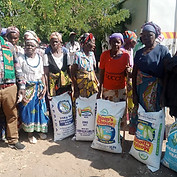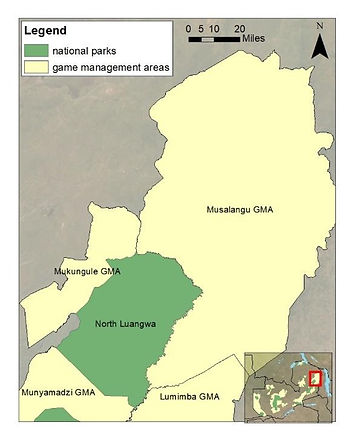
Musalangu GMA
Collaborative Management Partnership
Musalangu Game Management Area
Located within the picturesque landscapes of the Muchinga Province in Zambia, the Musalangu Game Management Area (GMA) occupies a pivotal position surronding the iconic North Luangwa National Park. Spanning approximately 17,350 km2 (over 4 million acres), the Musalangu GMA is not merely a geographic entity but a vital conduit for wildlife migration, genetic diversity, and ecological equilibrium.
The Musalangu GMA has evolved into a sanctuary for an array of wildlife species. Migratory buffalo herds, majestic elephants, lions and leopards, wild dogs, and endemic antelope species coalesce within its boundaries, crafting a vibrant tableau of natural diversity that enchants visitors and researchers alike.
Despite its ecological magnificence, Musalangu GMA confronts a spectrum of challenges outlined in its general management plan spanning 2020 to 2030. Deforestation, unsustainable fishing practices, poaching, habitat degradation, and human-wildlife conflicts beset the area, compounded by socio-economic disparities and infrastructural deficiencies that confront the estimated 8,500+ community members in the GMA.
In response to these pressing issues, a paradigm shift towards collaborative management partnerships emerges as imperative. Traditional government conservation methodologies have proven insufficient in addressing the multifaceted challenges plaguing Musalangu GMA. Instead, an inclusive approach uniting governmental bodies, local communities, conservation entities, and private stakeholders is indispensable in navigating towards a sustainable future for the GMA and its inhabitants.


The Musalangu GMA Collaborative Management Partnership
The Musalangu Game Management Area (GMA) epitomizes Zambia's rich tapestry of biodiversity and cultural significance, boasting diverse ecosystems and wildlife that are integral to the nation's ecological equilibrium and socio-economic prosperity. Considering the pressing need for concerted conservation efforts to safeguard this invaluable resource, the Collaborative Management Partnership between the local stakeholders and Kusunga Zambia Foundation (KZF) emerges as a beacon of hope. Together, these two envision a transformative Collaborative Management Partnership (CMP) for Musalangu GMA, grounded in the principles of cooperation and shared responsibility.
Central to this visionary approach is the establishment of a CMP that unites stakeholders, including the Department of National Parks and Wildlife (DNPW) and local communities. These traditional authorities play a pivotal role in the administration of Musalangu GMA, working hand in hand with the government to oversee the sustainable management of the land. Under their guidance, a network of headmen ensures the day-to-day stewardship of the area, employing traditional systems that have been passed down through generations.
In emphasizing the importance of local communities within this CMP, the CMP’s Board, Musalangu Game Management Board (MGMB) recognizes the inherent wisdom and intimate connection that community members possess with the land. These communities are not just inhabitants of Musalangu GMA but true custodians whose livelihoods and cultural heritage are intricately intertwined with its ecosystems. By empowering and engaging these communities in the conservation and management processes, the CMP aims to foster a sense of ownership and stewardship that is essential for the long-term preservation of Musalangu GMA. Together, through collaboration and mutual respect, KZF, DNPW, and local communities aspire to chart a sustainable path forward for Musalangu GMA, ensuring its protection for generations to come.
This strategic alliance is driven by the overarching goal of fostering biodiversity restoration, conservation-led economic activities, sustainable development initiatives and meaningful community beneficiation within the Musalangu GMA.
Collaborative Management Partnerships represent a dynamic approach to conservation and sustainable development, leveraging the collective expertise, resources, and commitment of diverse stakeholders. At its core, a CMP fosters shared decision-making, participatory governance, and equitable distribution of benefits among stakeholders, including local communities at the heart, government agencies, non-governmental organizations, and private sector entities.


Importance of CMPs in Conservation and Sustainable Development
The importance of collaborative management partnerships in conservation and associated responsible socio-economic development cannot be overstated. In an era marked by escalating environmental challenges and diminishing natural resources, such partnerships offer a holistic and inclusive framework for promoting socio-economic development through conservation management as a core land use. By engaging stakeholders at all levels, CMPs provides the mechanism to navigate through complex socio-ecological systems by facilitating the co-creation, implementation and adaptive management of strategies and solutions that balance conservation imperatives with the needs and aspirations of local communities and broader society.
Moreover, CMPs provide a platform for building mutual trust, fostering dialogue, and cultivating true ownership and stewardship among stakeholders. By fostering partnerships grounded in a collective vision, transparency, accountability, and shared values, CMPs enable the pooling of resources, knowledge, and best practices to achieve common conservation and associated socio-economic development goals and enhance the resilience of ecosystems and communities alike. In the context of Musalangu GMA, the proposed CMP represents a unique opportunity to harness synergies and mobilize collective action towards the sustainable development for improved well-being and conservation management of this vital landscape. Through a collaborative and inclusive approach, the CMP seeks to address pressing conservation challenges, promote biodiversity conservation, empower local communities, and foster sustainable livelihoods, thereby ensuring the long-term viability and resilience of Musalangu GMA for generations to come.



Natural Resources Management
Particular focus will be on substantially eliminating the illegal harvest of wildlife (e.g., poaching), reducing the illegal harvest of timber, promoting conservation farming practices, reducing the number of unplanned bushfires, and reducing human-wildlife encounters.
Local Community Engagement
The key areas the CMP will address include improving better access to medical and food supplies, creating alternative means of income such as beekeeping, general stores, and other micro-businesses, educating youth about the importance of protecting wildlife and habitats, and skill development to support commercial and tourism businesses operating in the GMA.
Infrastructure Development
Infrastructure Development plays a crucial role in enhancing the socio-economic and conservation aspects of the GMA. As such, a substantial portion of the donated funds to the CMP will be used to improve road networks, provide more boreholes for access to better-quality drinking water, and address the inadequate health, education, and game scout housing facilities in the GMA.
Current Situation
North and South Luangwa National Parks and their adjacent Game Management Areas (GMAs) along with the smaller parks and forest reserves form the 41,000 km2 (10,120,000 acres) Luangwa Valley Ecosystem. Communities living in the GMAs are represented by local institutions known as Village Action Groups (VAGs), which are grouped in relevant Community Resource Boards (CRBs).
The GMAs were formed by the Zambian government decades ago to act as buffer zones and are fundamental to the long-term integrity and functionality of the Parks and the greater ecosystem of the Luangwa River Valley, with the dual objectives of supporting both the conservation of wildlife and ecosystem processes and the sustainable livelihoods of resident communities.
In legislation, communities, VAGs and CRBs are charged with managing the natural resources of the GMAs and can assess and sign leases with potential investors, with support from the Department of National Parks and Wildlife (DNPW). Yet, in reality, numerous challenges hinder the effective engagement of communities with enterprise operators.
A significant focus of the Zambian government is to strengthen community participation in ecosystem conservation and to stimulate charitable and private investment in enterprise opportunities that will diversify and increase revenue streams for livelihoods while also ensuring adequate funding for wildlife and habitat conservation. It is envisioned that these goals will be achieved by enabling non-government organizations to partner with CRBs and VAGs to overcome the challenges they face that is leading to the deterioration of wildlife ecosystems in the buffer zones around the Parks.


